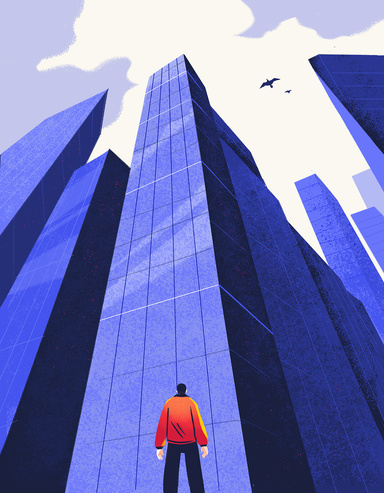When Chris Duey (BBA91) walks out of Principal Financial Group’s high rise office building in the heart of downtown Des Moines, he sees fewer folks on the street, less traffic, and quieter restaurants than he used to.
The rapid shift to remote work because of COVID-19 left many American cities grappling with an unprecedented surplus of vacant office space, said Duey, senior managing director for Principal Real Estate Investors.
Like all things real estate, location matters.
Cities where workers traditionally rely on public transportation or endure long commutes, such as San Francisco, have been hit the hardest. In these dense urban centers, daily office occupancy rates remain stubbornly low—often hovering below 50%.

Los Angeles’ downtown still has 37 million-square feet, or the equivalent to five full city blocks of offices sitting empty.
Conversely, in Sun Belt cities and areas like Austin, Texas, where public transit is less central to daily life and commuting is less burdensome, daily occupancy rates have stabilized around 65-70%.
Mid-sized hubs like Des Moines are facing mixed fortunes, where suburban markets typically perform better than their downtowns.
Recently, some urban planners and housing advocates have seized on the idea of converting this unused office space into housing. If successful, it would solve two problems at once: Finding an adaptive reuse for increasingly empty downtown buildings while also easing the housing crunch.
Unfortunately, the plan works better on paper than in reality.
According to Morgan Stanley data, a developer can buy an already completed multifamily property for around $600 per square foot. Building new is even cheaper, at around $580 per square foot. By contrast,the average cost of acquiring and converting an existing office building costs around $685 per square foot. At $100 per square foot more expensive, it’s hard to make the office-to-housing conversion math add up, particularly if you’re looking to make the new development affordable.
In addition, there are practical building concerns. Several architectural characteristics of office towers create significant hurdles, making the retrofit process both technically challenging and prohibitively expensive for most building owners. For example, modern office buildings are typically designed with expansive floor plates utilized to meet the needs of a corporate workforce— not residential living.
Joshua Moe, a project architect with OPN Architects in Iowa City, said buildings designed as workspaces often lack sufficient windows, are difficult to heat and cool if broken into individual units, and have plumbing designed for centralized restrooms.

“If you divide a massive square into several apartments, you either get several long, skinny apartments with only one window, apartments with no windows—which is not allowed, per code, or you get a very inefficient and thus expensive floor plan,” Moe said.
It’s also hard to make the numbers work. “In order of magnitude, the structure, envelope (windows), core, and systems are among the most expensive parts of a building,” he said. “If you have to deconstruct and reconstruct them all, it will cost you, and you’re still stuck with a building floorplan that isn’t ideal.”
These are among the reasons less than 2% of vacant office space is currently being turned into housing, according to Duey.
The high price tag also means it’s not a viable solution for addressing affordable housing needs afflicting many communities across the country, he added.
“Cities that are under-served for affordable housing aren’t going to fix that problem with office conversions,” he said. “The costs are just too great.”
This article appeared as part of a package in the 2025 issue of Exchange magazine about "hot topics" from the worlds of healthcare, tech, higher ed, real estate, and college sports.

More of the Hot Topics series:
911... is your emergency profitable?
Pay for play
AI's insatiable appetite
The enrollment cliff
Are pharma mergers evil?
